California is one of the US states with high and very high butterfly populations. All types of migratory and non-migratory species are found across the state.
Unique plants such as California buckeye attracts several butterfly species to the state. Most commonly, asters and wild lilac are among the favorite species of butterflies feeding on nectar in the state.
The warm Californian climate attracts many butterflies to the Southern parts of the state. Species fly from the North and the North East to escape harsh winters and to find more host plants such as stinging nettle.
Some of the species common in California are also large butterflies. A wingspan between 3 and 6 inches is common for some of the largest species across the state.
Some of the most common butterflies in the state such as Monarchs are facing a slight decline over the past few years while others are seeing increased numbers year on year.
California is also one of the few states where some rare types of butterflies are active throughout the year.
Here are the most common species that live in the state.
Table of Contents
1. Monarch
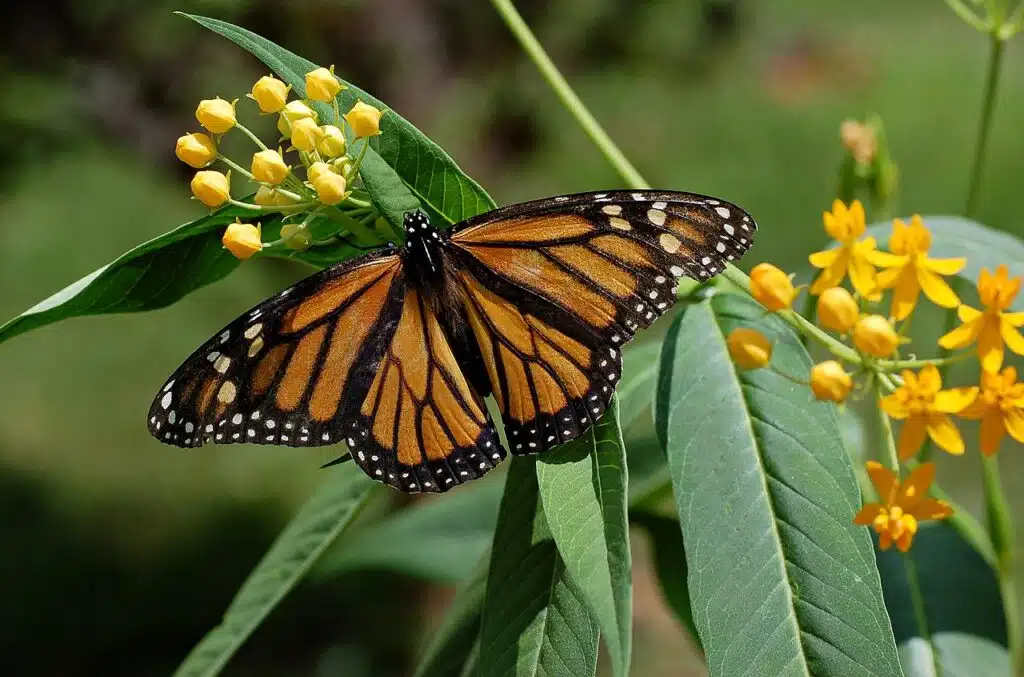
Monarch butterflies (Danaus plexippus) are some of the most common in California. Scrutinized in a few studies, Monarch butterflies show the population of the species is declining.
Monarch butterflies remain highly visible each year in California counting a few hundred thousand individuals.
These butterflies are seen migrating to California and other territories in Mexico from their summertime habitats West of The Rocky Mountains.
Southern California is the preferred migration spot for Monarchs flying in from Northern habitats.
With a wingspan between 3 and 4 inches, Monarch butterflies are also some of the largest seen in the state.
A combination of black and orange makes the species stand out. The base orange color of the wings is completed by black veins and wide black borders.
This species feeds on multiple types of plants such as Indian Hemp and Wild carrot.
Monarchs also feed on California milkweed in the Southern regions of the states.
Some data suggests that Monarchs that feed on milkweed aren’t as likely to migrate long distances are Monarchs that feed on other plants such as goldenrod or blazing stars.
2. Painted Lady
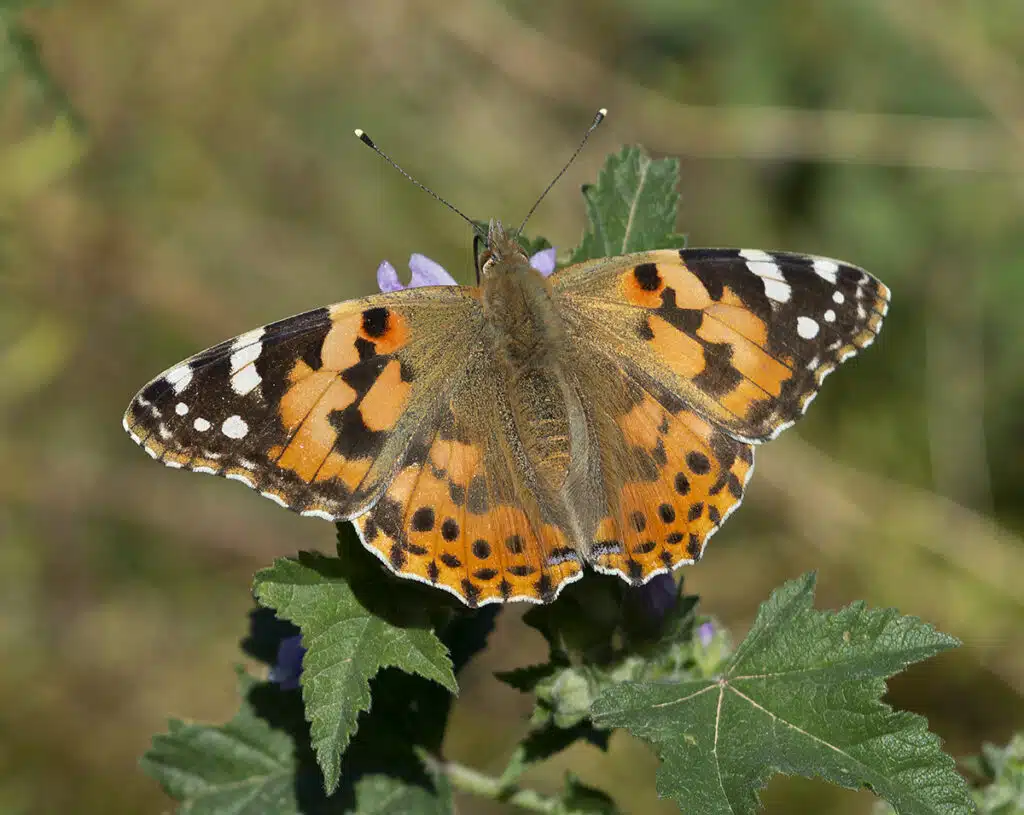
Painted Lady butterflies (Vanessa cardui) are some of the most common species of California both within the category of migrating butterflies and compared to other species in general.
Painted Lady butterflies have orange, brown, white, and black wings.
Orange is the main color of the species with black veins and black tips of the forewings. Black spots are seen on the orange part of the wings while white spots are seen on the black areas of the forewings.
White margins decorate the hindwings.
Painted Lady butterflies are a migratory species in California. They arrive in California through the Northern part of the state.
The rain which triggers the growth of the favorite host plants of the species is believed to be the most important factor to determine the scale of the migration.
Some of the largest Painted Lady California migrations took place just a few years back and they can take place again whenever desert regions get rain.
This triggers the growth of various species of asters, the flowers Painted Lady butterflies like the most.
3. Fiery Skipper
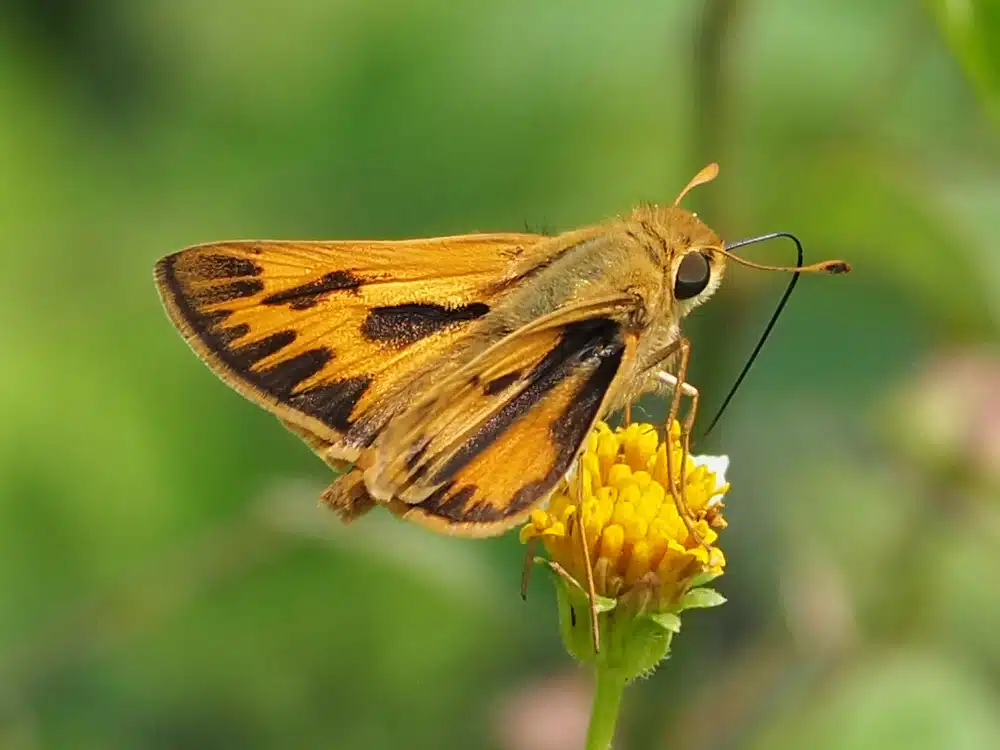
Fiery Skippers (Hylephila phyleus) are identified by their yellow or orange color. Females of the species are brown.
Subtle location-specific differences are also noted within the species.
Fiery Skippers are darker when found in Southern California as opposed to species elsewhere.
These butterflies are some of the most common pests of grasses in the state and they have been extensively researched.
A common lawn pest, Fiery Skippers are seen as a major threat to grasses in California and Hawaii.
This species is typically eliminated with insecticide either as a preventive measure or after they invade a territory.
Yellow or orange wing coloring is specific to these butterflies for easy identification. Dark brown margins complete the colorful look of the male butterfly while females are known for having a mostly dark brown color which is even darker in Southern California.
Fiery Skippers are found all around the state, specifically at low elevations.
You can identify a Fiery Skipper butterfly on your California lawn by the positioning of its wings.
These butterflies fold their upper wings in a triangle shape.
4. Variable Checkerspot
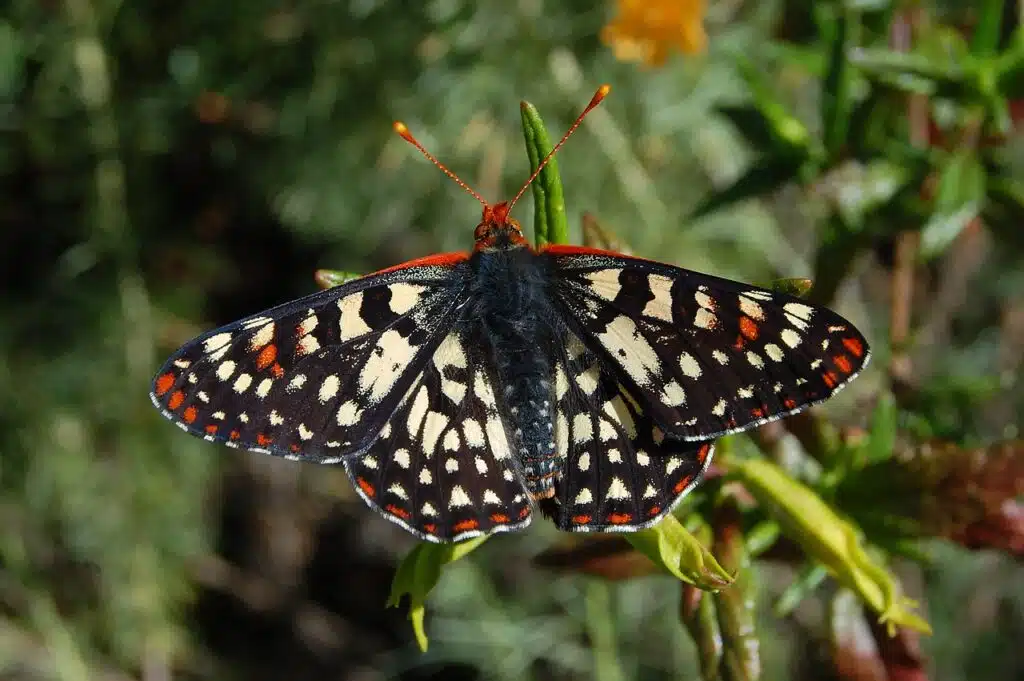
The Variable Checkerspot (Euphydryas chalcedona) is a common dark-colored butterfly in California.
Butterflies of this species are often seen in reserves but they like the weather and the plants available in California.
You can identify the species by its mostly black wing coloring. White spots are seen all across its wings while its margins are mostly red and black.
The Variable Checkerspot spends a lot of its life avoiding predators, mainly birds.
This is why it has evolved its ventral wings into a patterned look.
Variable Checkerspot butterflies like to feed on yerba santa as a caterpillar. This is a type of local plant.
The larvae of the Variable Checkerspot have a more diverse host list. It feeds on sticky-monkey flowers within and outside California.
It absorbs the toxins that give it a bad taste and which keep predators away.
The state is also home to the California bee plant. This is a similar species of wildflowers without toxins.
Variable Checkerspot caterpillars like this species as well. While they do not obtain any toxins from it for defensive purposes, caterpillars of the species tend to grow faster on the California bee plant as this species is easier on the digestive system.
5. Gray Buckeye
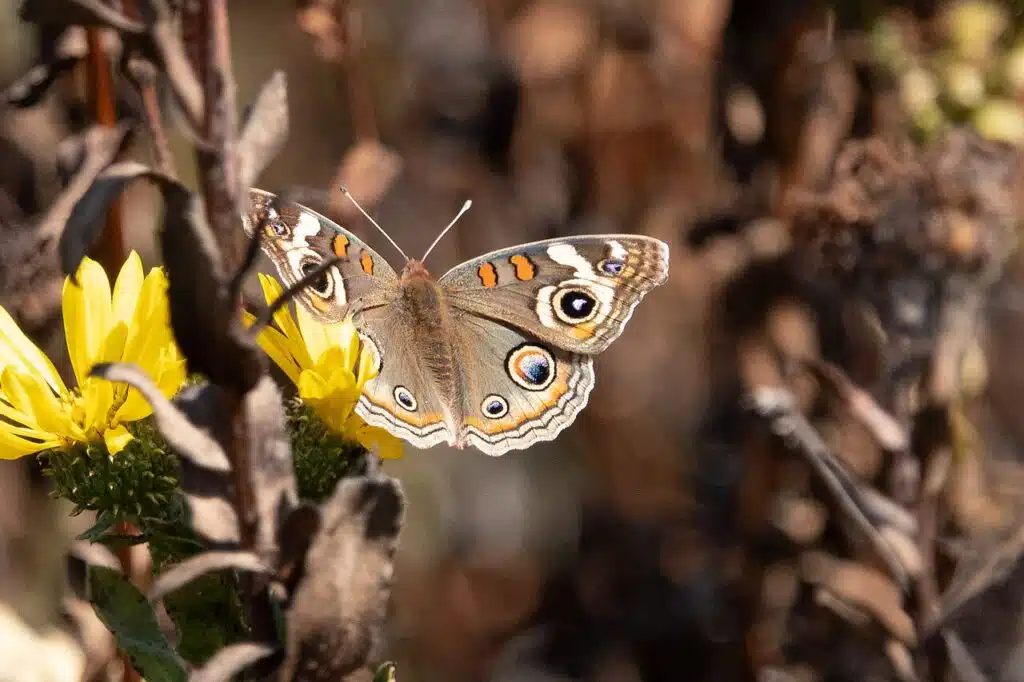
Gray Buckeye butterflies (Junonia grisea) are a subspecies of the Common Buckeye.
The range of these colorful butterflies includes California and an extended territory to the West of The Rocky Mountains.
Gray Buckeye butterflies have a gradient gray base color, with orange, brown, black, and white completing colors.
The dark gray coloring is specific to its forewings while light gray coloring is seen across its hindwings.
The species is mostly known for its very large eyespots.
Located on the margins of the wings, these eyespots can be interpreted as defensive adaptations to make the species look larger and fearsome.
The final margin section between the eyespots and the edges of the wings is orange so that the brown and black eyespots stand out even more.
6. Cabbage White
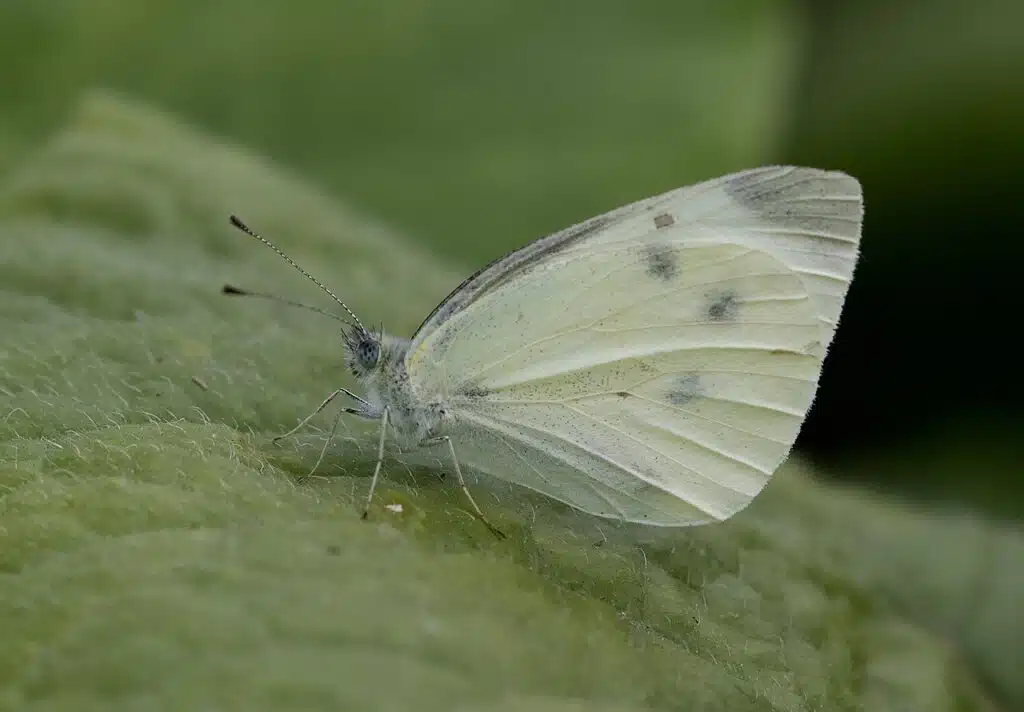
Cabbage White butterflies (Pieris rapae) are a complex species with a pest status in its caterpillar stage.
The Cabbage White caterpillar is also known as the Cabbage Worm around the state. This type of caterpillar feeds on cabbages and related crucifers.
Its damages are considerable and in an estimated amount of millions of dollars in California and nearby states.
While Cabbage White caterpillars are predated by birds, they still cause major economic losses every year.
Cabbage White adult butterflies feed on yellow and white flowers without any direct impact on crucifers.
You can identify these adult butterflies by their cream-to-white color with a black or dark gray body.
Females of the species are further differentiated from males by the dark spots they have on the central section of the wings.
The ventral side of the wings has a similar cream to white color. The folded wing position of the species helps it remain undetected on flowers.
Asters are among the most common flowers these butterflies are seen on.
7. Gulf Fritillary
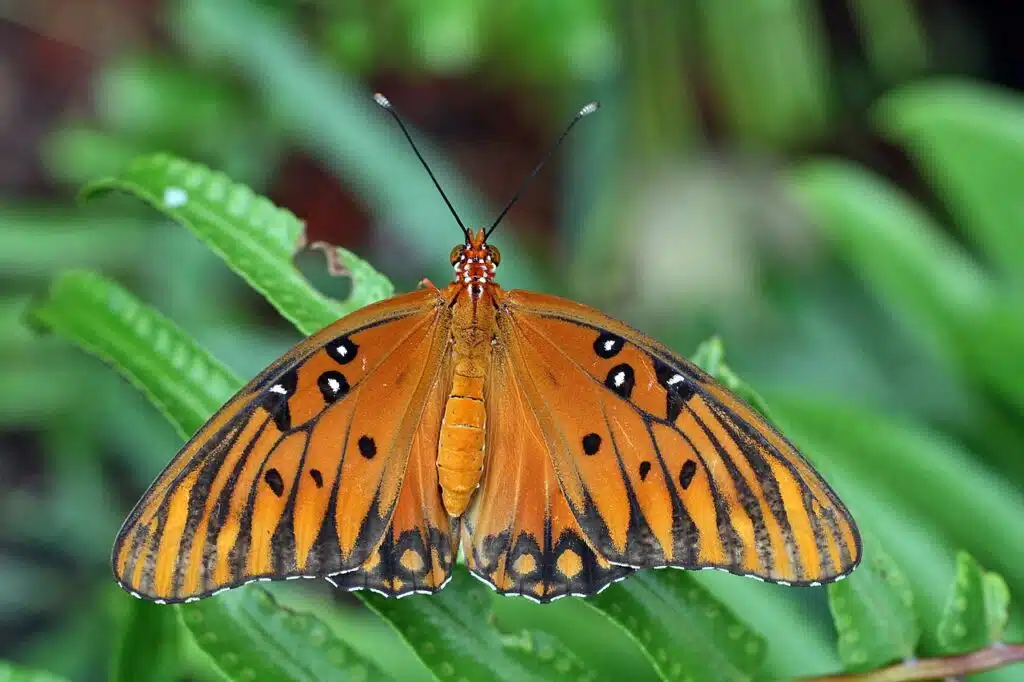
These types of butterflies (Dione vanillae) have become very common in California over the past decade.
While not as popular as in Florida, Gulf Fritillary butterflies are seen at least twice per year in the state which is used both as a migration destination and as a migration route toward Mexico.
This species of butterfly has a base orange color with black lines and black dots that have white central sections.
Butterflies of this family have orange to brown body colors.
Light brown coloring is also specific to the ventral side of its wings. Large white dots decorate the brown sections of the wings.
Gulf Fritillary caterpillars have some of the colors seen in adults. The larvae of the species have orange to brown coloring with black stripes.
The caterpillars of this species feed on passionflowers.
Adults are among the species which release certain defensive odors in the presence of possible predators.
Approaching birds are met with an unpleasant odor. Both males and females have defensive glands used to release the odors which are based on the accumulation of toxins from their host plants.
8. Western Tiger Swallowtail
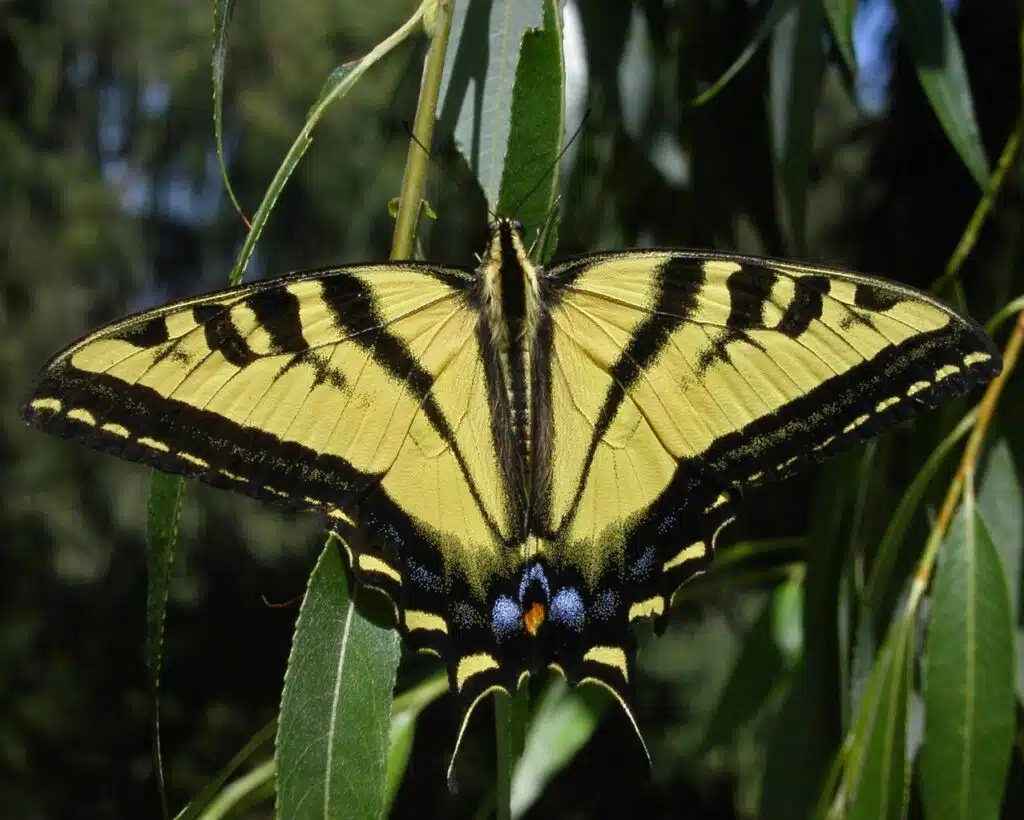
Western Tiger Swallowtails (Papilio rutulus) are some of the largest native species in California. This butterfly can have a wingspan longer than 4 inches.
A dual yellow and black color characterizes the look of the species.
Yellow base coloring with black stripes and black bands are seen on this species of butterflies.
The ventral side of the wings is also dominated by black and yellow colors.
Commonly inhabiting the Western Coast, this butterfly species is known to feed on multiple plants.
It has very specific reasons to be in California, a state rich in unique plants and flowers in the region.
This species eats California buckeye and yerba santa as food. Adults feed on them every day.
Caterpillars of the species aren’t as keen on feeding on California buckeye as they prefer willows, cottonwood, and ash.
This is one of the reasons the Western Tiger Swallowtail is seen around water sources as these are the ideal places where willows grow.
9. Anise Swallowtail
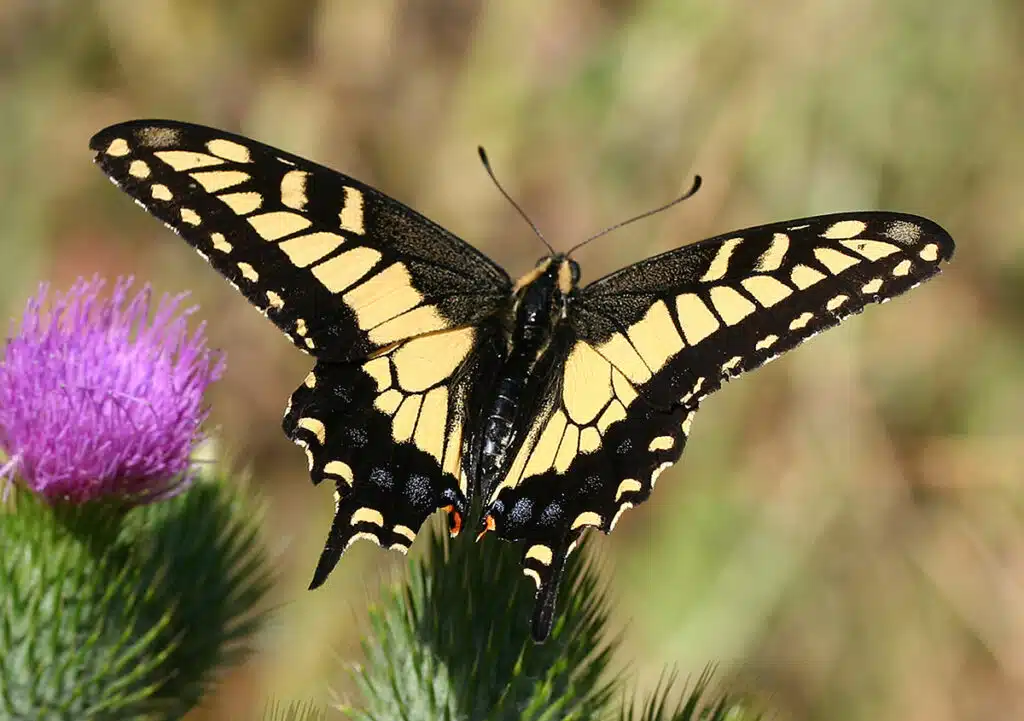
Anise Swallowtails (Papilio zelicaon) are some of the most common butterflies with a wingspan of around 3 inches in the state.
You can identify the species by a combination of black and yellow colors across the wings and by 2 short tails.
Yellow is the base color of the wings with black veins decorating the forewings and the hindwings.
Wide black margins with small yellow spots are further seen on these butterflies.
Orange spots are visible on the lower side of the hindwings.
This species is found in almost equal distribution across Northern and Southern California.
You can find the species in the Northern parts of the state around Sacramento Valley.
Wild carrots and wild parsley are among the most common foods for Anise Swallowtail butterflies.
Citruses are also a common host for the species. As a result, you can find Anise Swallowtails all around the state and in your garden.
10. Acmon Blue
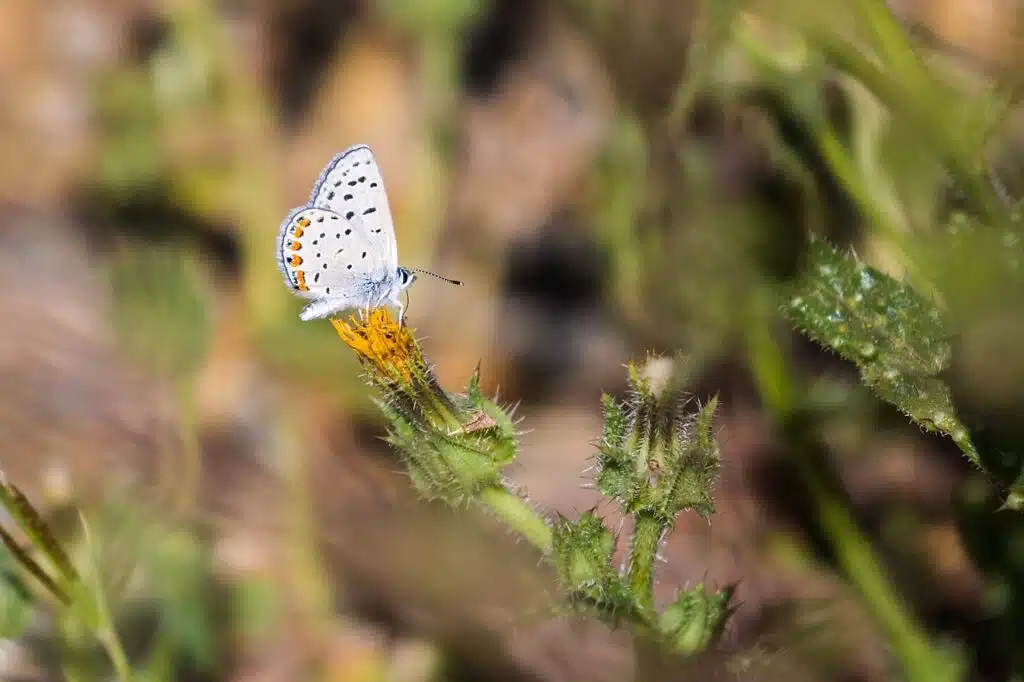
Acmon Blue butterflies (Icaricia acmon) are mostly native to California and immediate habitats in nearby states.
It can be found Southwards in Baja California as well.
This is a blue butterfly species with a short wingspan. The dark blue coloring is distinguished on its dorsal wings.
Black wing margins are seen on the forewings. The hindwings show an orange band and white margins.
Rather dark dorsally, this species has a white to gray coloring of the ventral wings. Small black dots and an orange line across the margins are also distinguished on the ventral side of the wings.
The Acmon Blue is a species that lives in various habitats. From deserts to coastal regions or from heels to marshes, this species is found almost everywhere around the state.
Adults feed on wildflower nectar while the Acmon Blue caterpillar feeds on local buckwheat.
11. Mourning Cloak
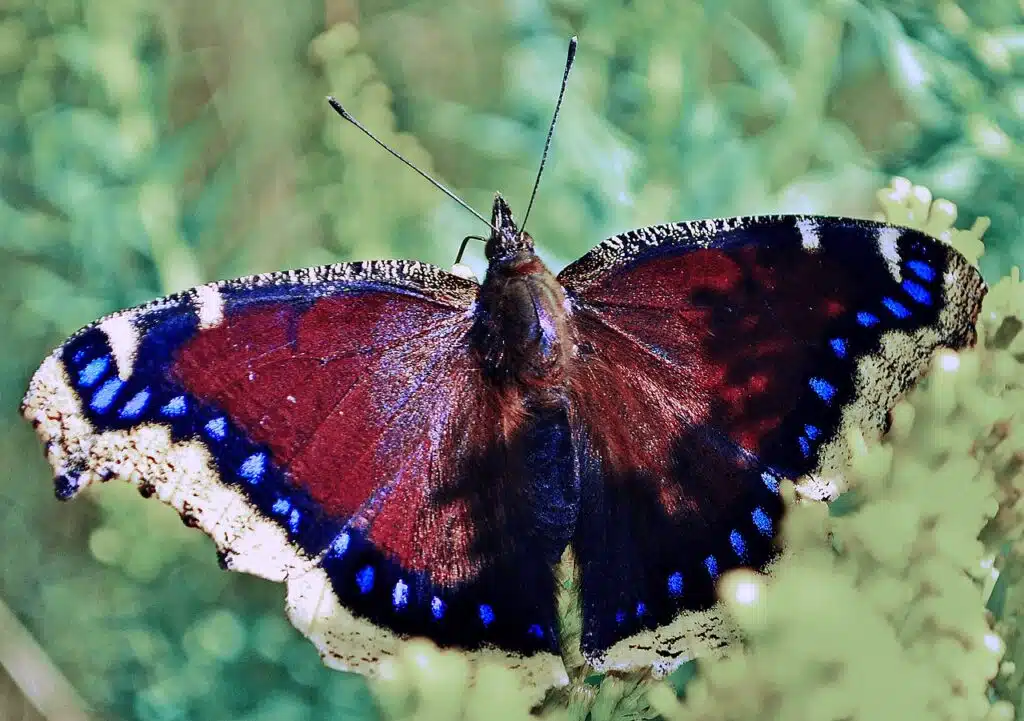
Mourning Cloaks (Nymphalis antiopa) are some of the most common pest butterflies in California.
This species has a dark brown color with an off-white to yellow band along the wings. This species has tiny blue spots along the margins of the wings.
You can further identify this species by its dark gray and light gray ventral color.
This ventral color is used as a defensive mechanism. The butterfly stops on tree bark showing its ventral wings which makes it difficult to spot due to the camouflaging coloring on this side of the wings.
Seeing the caterpillar of this species on a tree is a bad sign as the larvae can completely defoliate a host tree.
Examples of host trees defoliated by Mourning Clock caterpillars include willow and poplar.
It’s not exactly clear where large numbers of caterpillars come from host trees. Some say these butterflies do not migrate.
Other theories show the Morning Cloak as one of the possible North American native species that migrate to Central America.
12. Gray Hairstreak
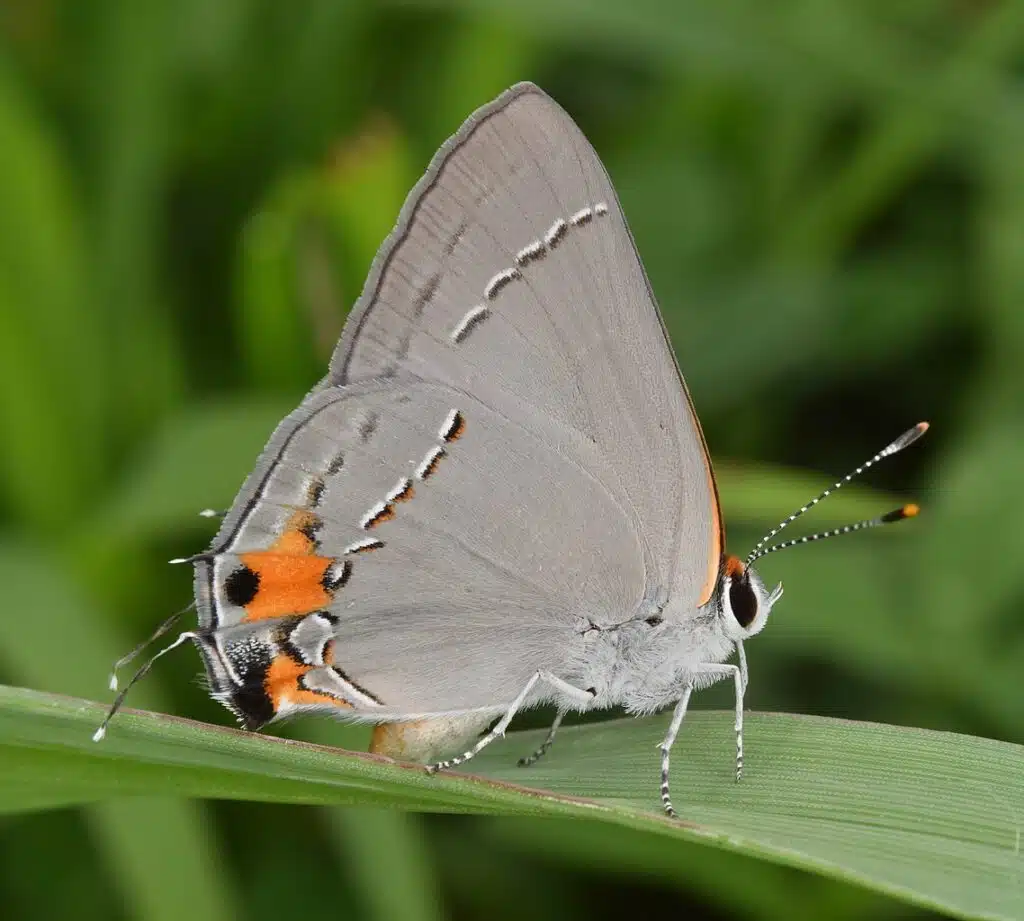
Clovers in the state attract many Gray Hairstreak butterflies (Strymon melinus). Bush clovers and other clovers are the preferred food of Gray Hairstreaks.
These butterflies also feed on mallows alternatively.
Pea family plants are also used as hosts for the caterpillars of the Gray Hairstreak.
This category of butterflies is further differentiated by its 2-3 broods per year. These butterflies remain active until November in some parts of the state.
You can see Gray Hairstreaks in almost another habitat as they often feed on mints, a herb grown in gardens.
A dark gray to blue color is specific to the dorsal wings of the species. White margins are also seen on this species.
Orange spots are further visible on its hindwings.
Butterflies of this genus have white to gray ventral wings coloring. Black dots and yellow bands are also seen on its ventral forewings.
Caterpillars of this genus have a white and pink color.
13. Umber Skipper
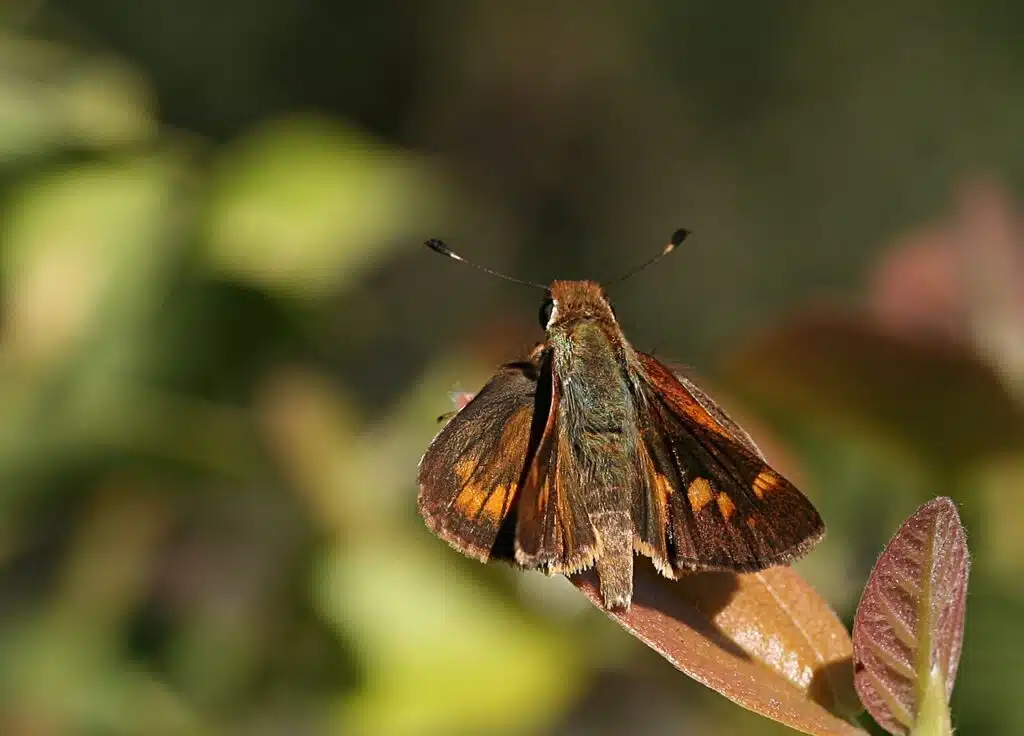
Umber Skipper butterflies (Lon melane) are most common in California even if they are also native to other Southwestern regions.
The butterflies have a dark color and a wingspan of just over 1 inch.
A triangle shape can be formed by the butterfly folding the forewings while its hindwings remain flat.
Brown and yellow coloring characterize the species which is known for its rather dark look.
Lighter brown and yellow colors are also seen across the ventral side of its wings.
The body is also colored in brown and yellow nuances.
This species feeds on many plants and it also uses many plants as a host for its caterpillars. California-exclusive plants are among his favorites.
California brome and San Diego sedge are some of the most common hosts for its caterpillars within the state.
Adults aren’t as tied to a certain plant or flower as caterpillars. This is the reason Umber Skipper adults feed on flower nectar from many types of wildflowers.
14. California Sister
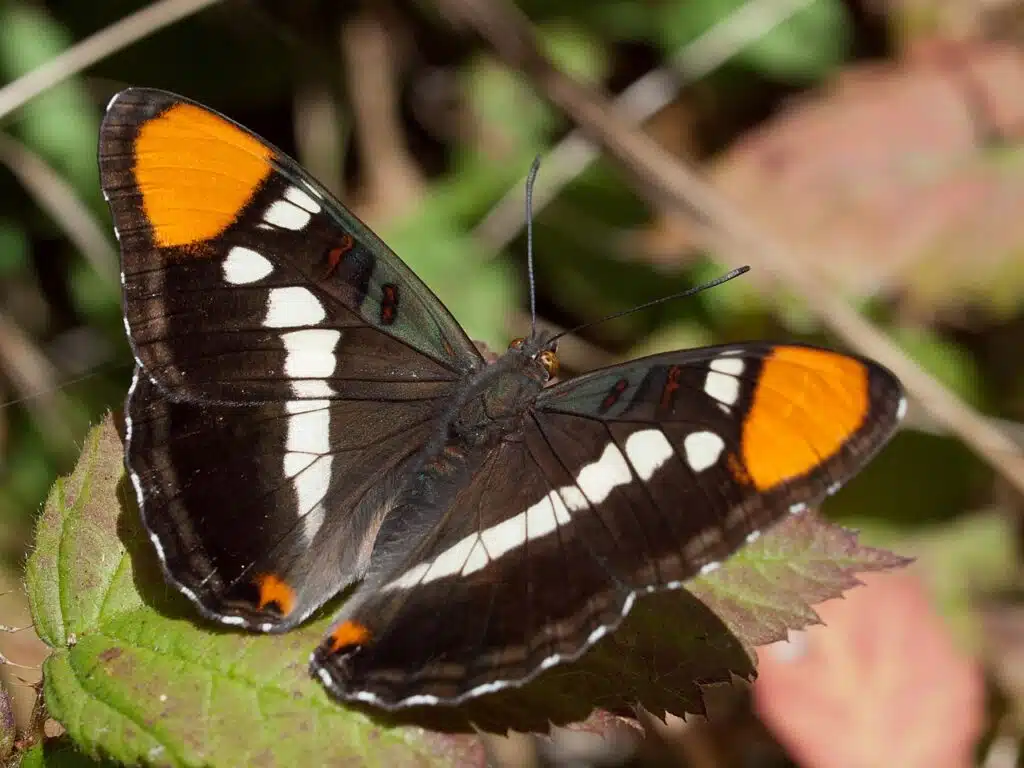
The California Sister (Adelpha californica) is among the small black native species common in the state.
This butterfly mostly lives in California but it’s also found along the West Coast.
Black is the main color of the species. Its wings are mostly black while its upper wings also show white bands and red spots across the tips of the forewings.
The body and the antennae are also all-black.
California Sister butterflies are easy to spot at medium to high elevations on hills and mountains.
They live in or around woodlands, particularly oak woodlands.
Butterflies of the California Sister genus feed on Canyon oak and Coastal live oaks as caterpillars.
Adults are known to prefer other organic food such as dung and even mud. Puddling is a common process in the species.
This is the occasion adults take to feed on the organic nutrients in mud while in a group.
15. Pipevine Swallowtail
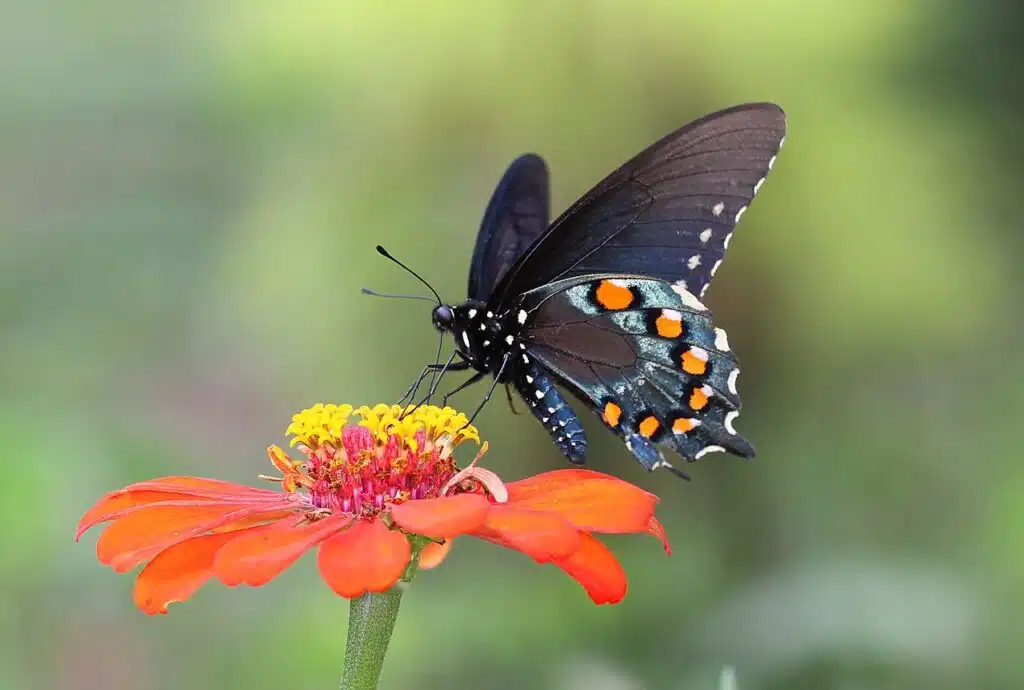
This black and blue butterfly (Battus philenor) is a common sight in California. Most Pipevine Swallowtails live on the Eastern side of us.
A smaller population of Pipevine Swallowtails is seen across Northern and Central California.
There aren’t many differences between California Pipevine Swallowtails and Eastern Pipevine Swallowtails apart from the size.
Pipevine Swallowtails tend to be smaller in California than elsewhere around the US.
Black forewings help distinguish this species. Its hindwings are blue but are only visible in flight.
The blue sections of the ventral hindwings have large orange spots and small white marks across.
Pipevine Swallowtails are known to mimic other species and other butterflies are also known for mimicking these butterflies for defensive purposes
Females Pipevine Swallowtails are known to feed on pollen during the day. Males tend to seek out females just as often as seeking out food.
The male Pipevine Swallowtails also get involved in drinking nutrients from mud together with other males as females only consume plant nectar.
The more males feed on mud in a certain area, the more likely other males are to join.
16. Red Admiral

Red Admirals (Vanessa atalanta) are common in California during the winter. They migrate from the North and mate as soon as they arrive in the state.
This species then only mates again in the spring when it moves back North.
Red Admirals have a complex mating strategy based on their territorial nature.
These butterflies are mostly black with red bands and white marks across the forewings.
Some Red Admirals only have black forewings and brown hindwings. This morph has orange bands instead of yellow bands.
Red Admirals butterflies have brown and black ventral hindwings while the forewings are also mostly black.
This species is mostly found in areas of the state with a good choice of stinging nettle.
This is the most common host plant for the species and the main reason Red Admirals move South in late fall when there’s new stinging nettle in the state.
17. Common Ringlet
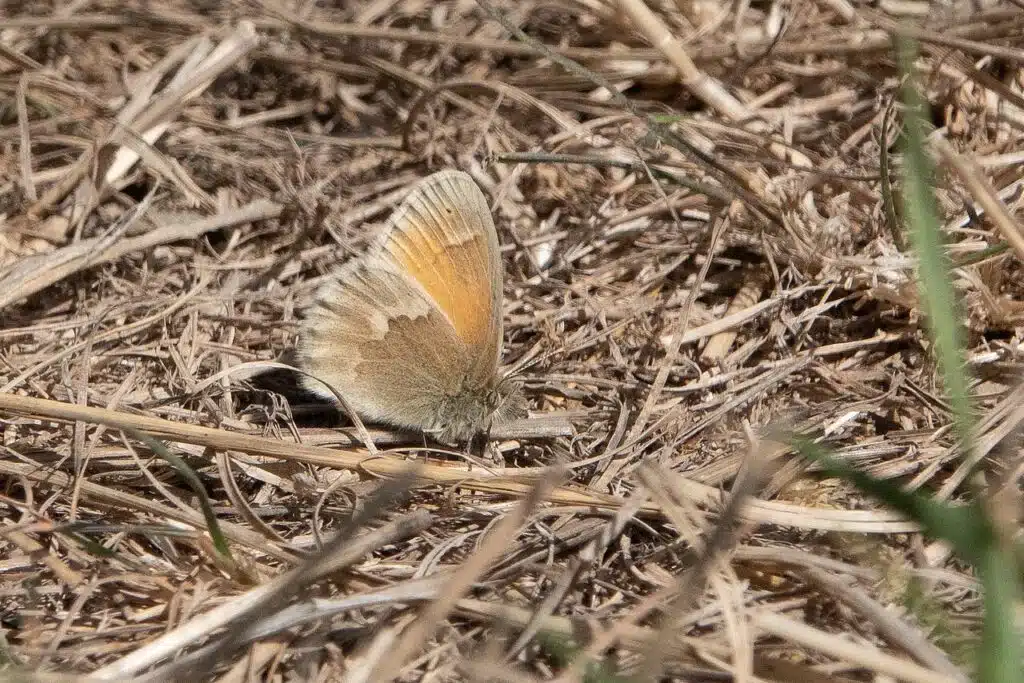
Common Ringlet butterflies (Coenonympha california) are a small species with variable coloring present in California and outside of the state.
This small species has a short wingspan of just over 1 inch.
Its wings are mostly orange but they can also be gray, brown, or tan.
High coloring variation for the species is signaled around the US and even within California.
The butterfly has a widespread presence from Oregon to Baja California.
You can see it on fields and meadows as well as in parks and other open areas.
Adult Common Ringlet butterflies feed on a wide range of grasses with the potential of becoming a pest in parks and gardens.
18. Lorquin’s Admiral
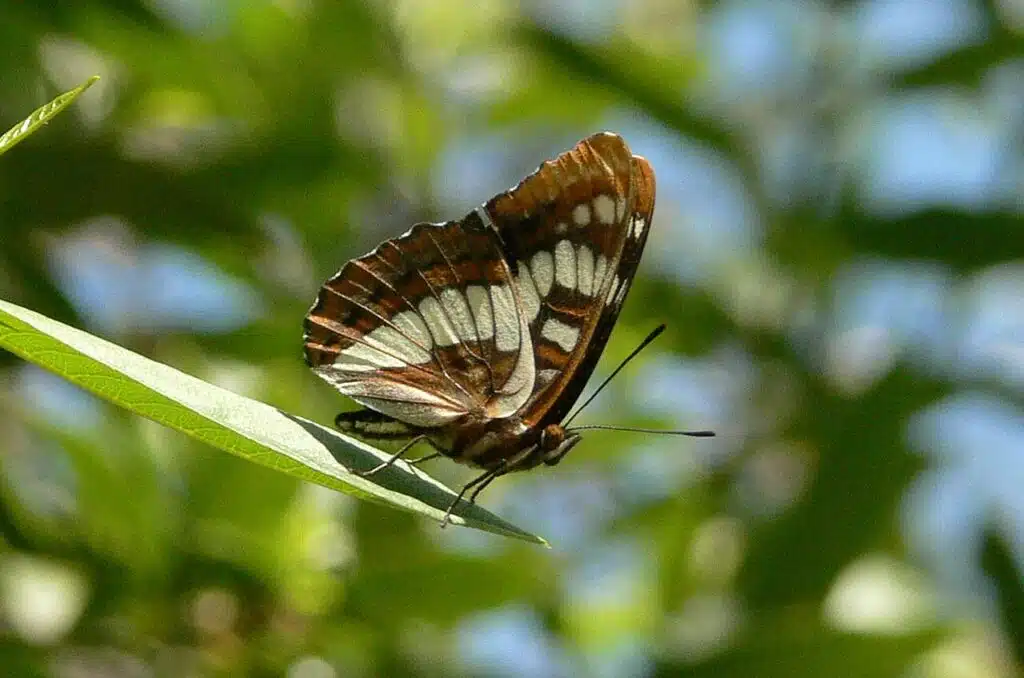
This species (Limenitis lorquini) is one of the most common Admirals in California. It’s also one of the most aggressive and highly territorial butterflies in the state.
You can identify this species by its black wings with orange forewing tips. White spots decorate the margins of its forewings and its hindwings.
The species has a colorful ventral coloration as well. Brown, orange, and dark brown patterns are seen on its ventral wings.
Black veins and large white spots are further visible on its ventral wings.
There are many reasons why Lorquin’s Admiral is present in California. Yerba Santa and California Buckeye are some of its favorite plants that are native to the state.
Lorquin’s Admiral caterpillars don’t feed on these plants. They prefer willows and other trees as hosts.
19. Marine Blue

Marine Blue (Leptotes marina) are some of the most colorful butterflies found in California. This species got its name from its purple-blue coloring mostly visible in males.
Brown is the base color of the dorsal wings of the male and the female. Male Marine Blue butterflies also show purple coloring on the upper body and the central area of the forewings.
The ventral coloring of the species is a combination of brown and white wavy lines. Large blue eyespots are further seen on the ventral wings of the species.
Marine Blue butterflies aren’t a major threat to California crops whenever their population is controlled.
It’s the Marine Blue caterpillar that can be most problematic. The caterpillar of the species grows on alfalfa.
You can find Marine Blue butterflies and caterpillars all across the state until Baja California.
20. Mylitta Crescent
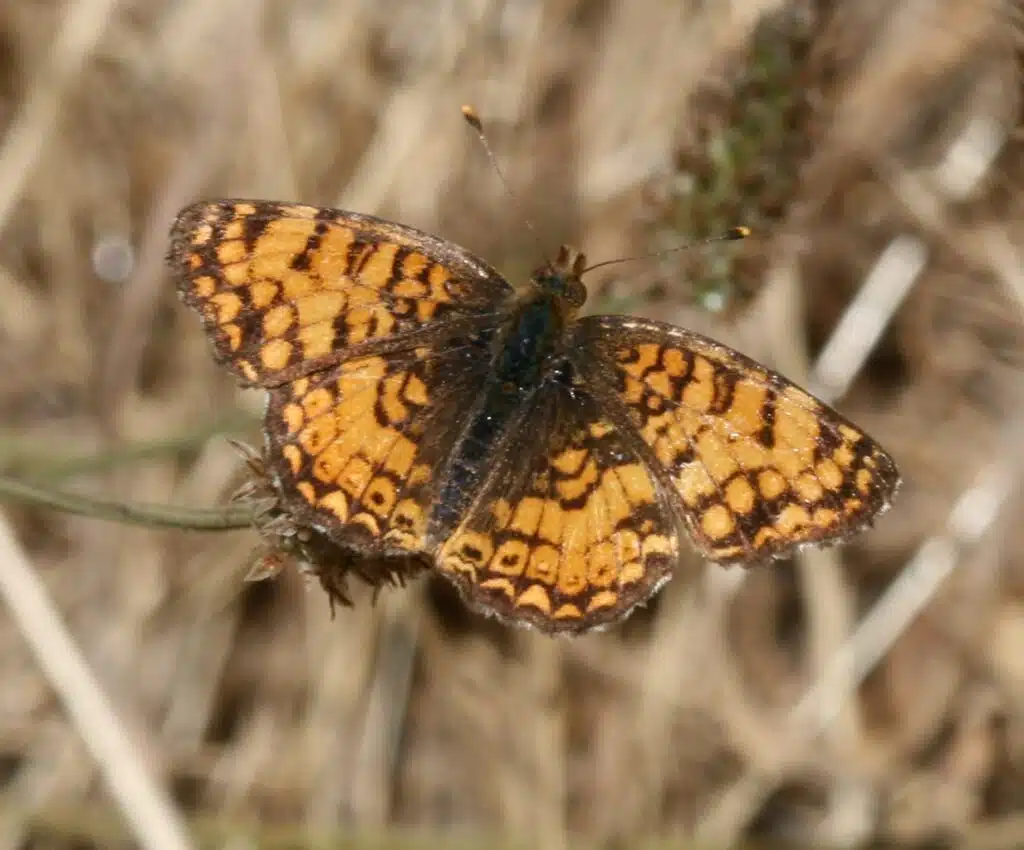
With a wingspan of up to 37mm, the Mylitta Crescent (Phyciodes mylitta) is one of the widespread North American species with a presence in California.
This butterfly has an orange or orange-red base color with black or brown checkered patterns and a similarly-colored body.
Mylitta Crescent butterflies are some of the most common species feeding on thistles as caterpillars.
Asters are also a common host for the Mylitta Crescent caterpillar while adults move on to consume nectar from multiple flowers.
Only absent from December to January, this active species has a long flight season. You can find it at a different elevation.
Mylitta Crescent butterflies are among the species commonly found even at an elevation of up to a few thousand feet.
You can find butterflies in open areas such as meadows. It also lives in parks and on the edges of woodlands where the wildflowers adults and caterpillars feed on.
21. Pale Swallowtail
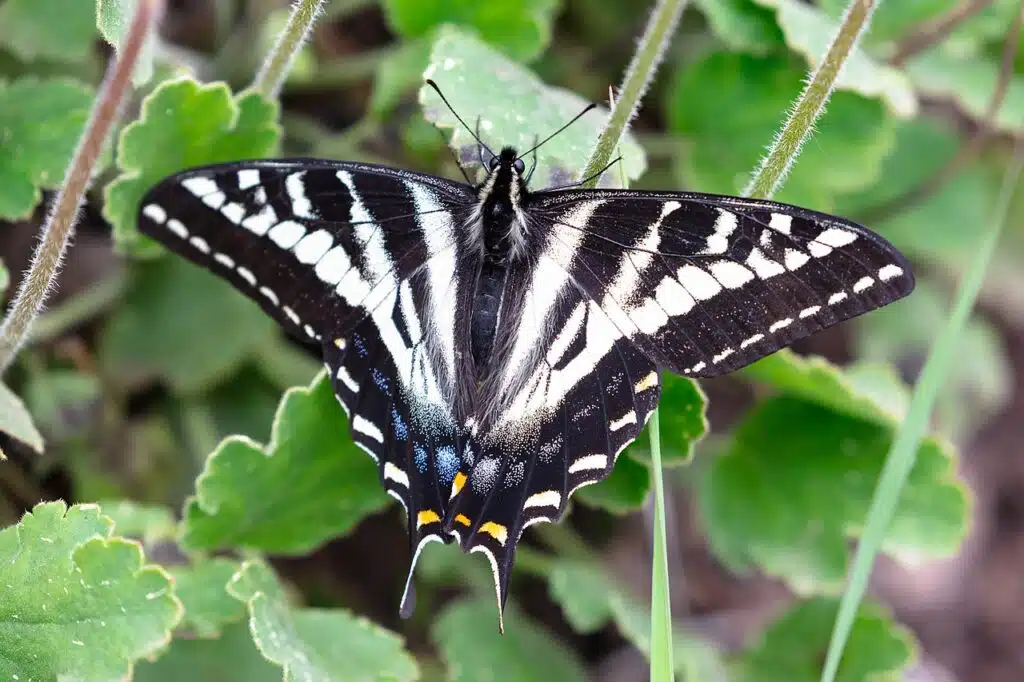
Pale Swallowtails (Papilio eurymedon) are a common species of large butterflies in California. This species doesn’t have the large numbers of the Western Tiger Swallowtail in the region, but it’s still seen in high numbers.
You can find Pale Swallowtails either in woodland openings or next to lakes, rivers, and ponds.
This species likes areas of high humidity and areas with plenty of water as this creates mud for puddling.
Male Pale Swallowtails are seen eating their way through the mud to drink nutrient-rich water.
The size and coloring of the Pale Swallowtail make it a clear sight in its natural habitat.
Similar to zebra butterflies, this specie has a black and white color and an average wingspan between 3 and 4.5 inches.
Pale Swallowtails have alternating black and white bands across their wings. Both the forewings and the hindwings are seen with contrasting black and white bands.
This butterfly species has a black body with 2 white longitudinal stripes and a black head.
Wide black margins are distinguished across the wings. These black margins are decorated with tiny white stripes and half-moon white shapes on the lower wings.
The species also shows blue, yellow, and orange marks on the lower hindwings and 2 black and white tails.
22. California Tortoiseshell
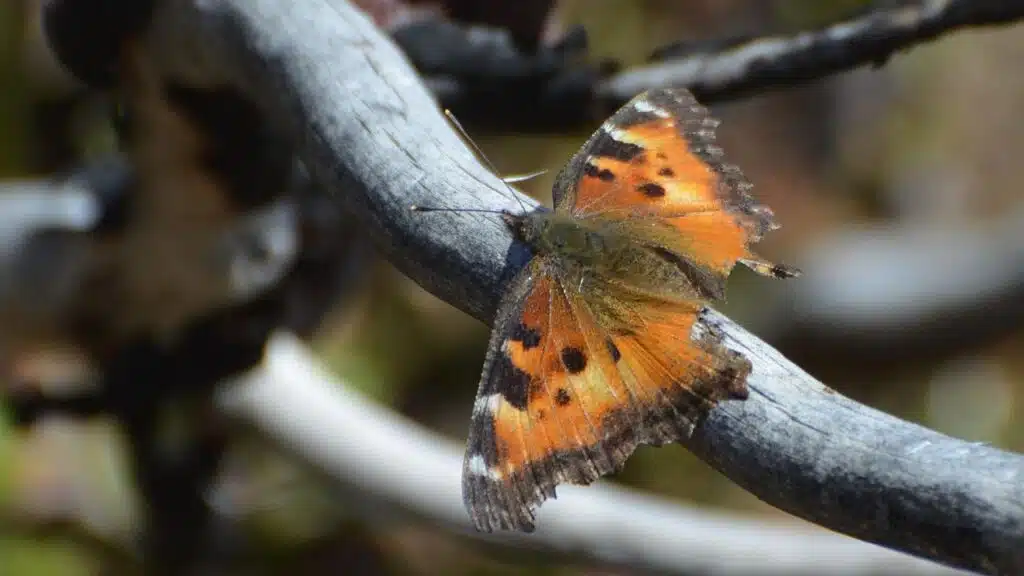
California Tortoiseshell butterflies (Nymphalis californica) are a small species that live in woodlands and woodland openings.
This species is found throughout the West Coast up to British Colombia in Canada.
A high population of California Tortoiseshell is specific to the warmer months in the state.
These butterflies can sometimes migrate East, especially towards New York from their Western territories.
True migrations are rare and the butterflies in California rarely migrate.
These butterflies are among the small to medium species in the state, with an average wingspan of 2 inches.
A natural habitat involving woodlands impacts the coloring of their ventral wings which are brown, dark brown, and black to mimic dead leaves to avoid predation.
The ventral wings of the species are more colorful.
Orange or orange to brown is the main colors of the dorsal wings of the species.
Yellow areas and dark brown spots are seen across the wings of the species.
Black and brown wing margins further decorate the dorsal side of the wings.
These butterflies further stand out in their caterpillar stage by host plant choice. California Tortoiseshell butterflies grow on lilac.
23. Echo Azure
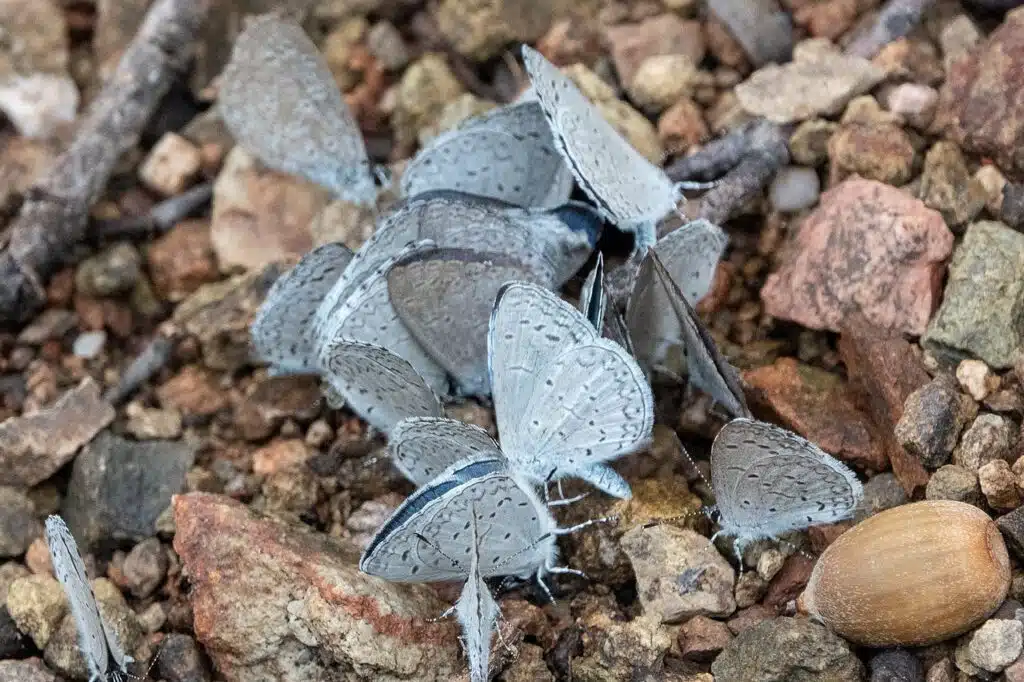
A very large population of Echo Azures (Celastrina echo) lives in California. These butterflies are seen from springtime to October.
Echo Azure butterflies are differentiated by their base blue color with triangle-shaped wing marks facing the upper side of the wings.
This species has black and white wing borders and a dark blue body.
Small round-shaped white eggs are laid by the female Echo Azure directly on flower buds.
One to 3 broods of butterflies emerge each year.
This species bears some resembled the California Tortoiseshell when it comes to its host plant. Wild lilacs are often chosen to lay eggs on.
Other more state-specific host plants for Echo Azures include California buckeye.
Adults feed on nectar from various species.
Echo Azure butterflies are further differentiated by their range. They prefer woodlands, woodland openings, medium elevation plains, and chapparal.
The species has accommodated areas rich in plants at a higher elevation such as habitats next to mountain streams.
24. Checkered White

Checkered Whites (Pontia protodice) are some of the most common white small butterflies in California.
Small coloring differences between male and female Checkered White butterflies exist, but both sexes are mostly white.
Females tend to show extra brown or gray spots.
While the dorsal wings are white the ventral wings are mostly brown with partial white patterns across the forewings and the hindwings.
Checkered White butterflies have a small size compared to other species in the state. These butterflies have a wingspan of up to 1.5 inches but are often seen in open areas.
Dry open woodlands, prairies, trails, meadows, valleys, and hills are all places that are suitable for this species.
Mustards are one of the flower categories most specific to this species.
Asters and alfalfa are secondary host plants for this species.
Migration happens within the state of the species. A disconnect between the sexual maturity between males and females triggers the migration of the species.
Males are ready to mate sooner than females and they tend to overwhelm and area with females.
As a result, the female Checkered White butterfly might migrate to an area with fewer males.
25. West Coast Lady
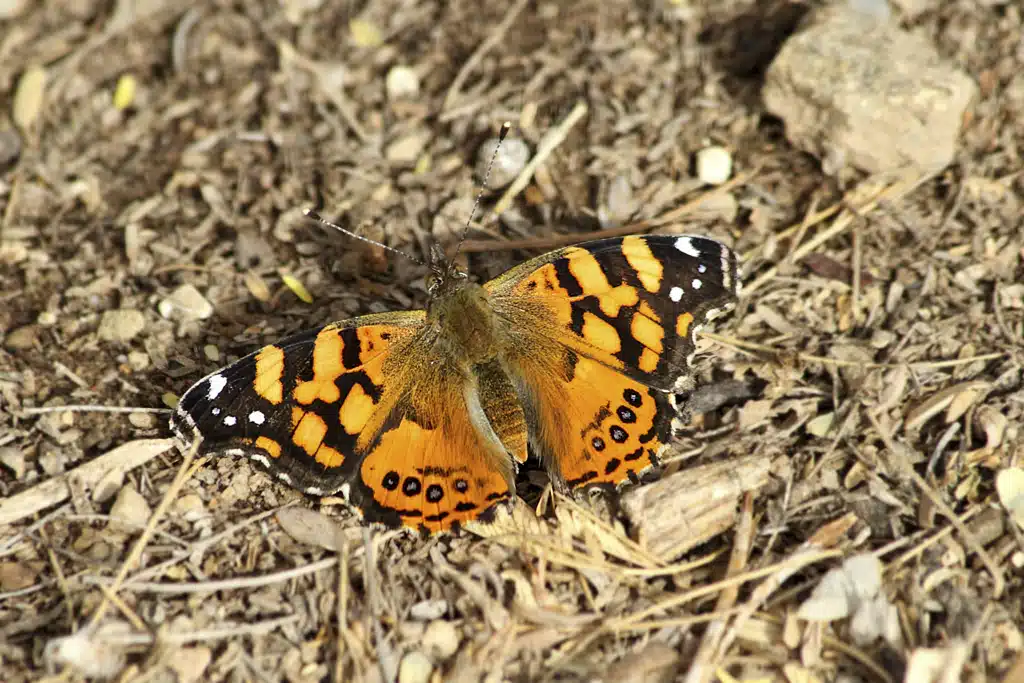
West Coast Lady butterflies (Vanessa annabella) are a common small orange species across the state.
These butterflies are commonly found around all types of habitats such as chapparal and other dry areas.
The species is easily confused with other orange butterflies in the state.
You can identify West Coast Lady butterflies by their base orange to brown color. The central section of the wings and the body are brown.
The outer edges of the forewings are dark brown to black with white spots across.
Large eyespots are seen across the lower hindwings.
Mallows are the favorite host plant of the species with a large impact on the feeding habits of adults in an area.
West Coast Lady butterflies are a colorful species often confused with other butterflies of the same family.
American Painted Lady butterflies and Painted Lady butterflies are the 2 other species found across North America and partially through Central America.
Brown and orange or black and orange color combinations are also common in these species of butterflies albeit their habitat doesn’t overlap.
26. Western Pygmy-Blue

Western Pygmy-Blue butterflies (Brephidium exilis) are one of the smallest species in California. While it can reach a wingspan of up to 20mm, it’s not uncommon for the species to have an even shorter wingspan.
You can identify the butterfly further by its brown color. Dark brown to black coloring is seen across most of its dorsal wings.
Both the forewings and the hindwings of the species are mostly dark brown.
Bold black patches are seen on the margins of its hindwings while its upper body is also black.
White hairs and faint white overlays decorate the forewings.
The ventral coloring of the species is also mostly brown but of a lighter nuance.
Western Pygmy-Blue butterflies have light yellow ventral wings with white stripes all across the forewings and the hindwings.
Large black eyespots are seen across the wings of the species.
Its legs and antennae are both white and brown.
You can find this small butterfly species all across the state. Old fields with pigweed tend to be some of their preferred habitats.
27. Western Giant Swallowtail
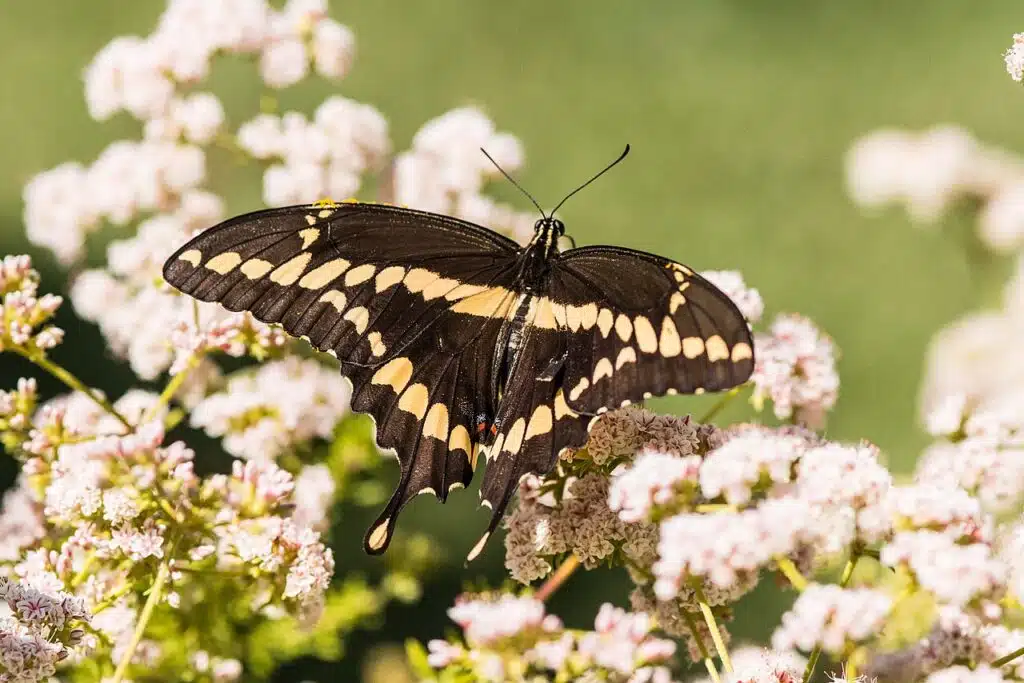
Western Giant Swallowtails (Papilio rumiko) are some of the largest butterflies in California.
These butterflies grow to a wingspan of up to 58mm and are commonly found across the state in various habitats.
Wafer ash and wild lime are the most common hosts of the Western Giant Swallowtail caterpillar and the most common place to see the species.
These plants and their leaves are used as food by the caterpillar.
Western Giant Swallowtail butterflies are identified by large brown wings with yellow decorations.
Dark brown is the main color of the forewings and the hindwings. Yellow spots run along the margins of the forewings and the hindwings.
There’s a large V-shaped band across the forewings of the species.
The same 2 colors of the dorsal wings are also seen on the ventral wings.
Yellow is the main color of the ventral wings with brown spots and brown stripes across the forewings.
28. Behr’s Metalmark
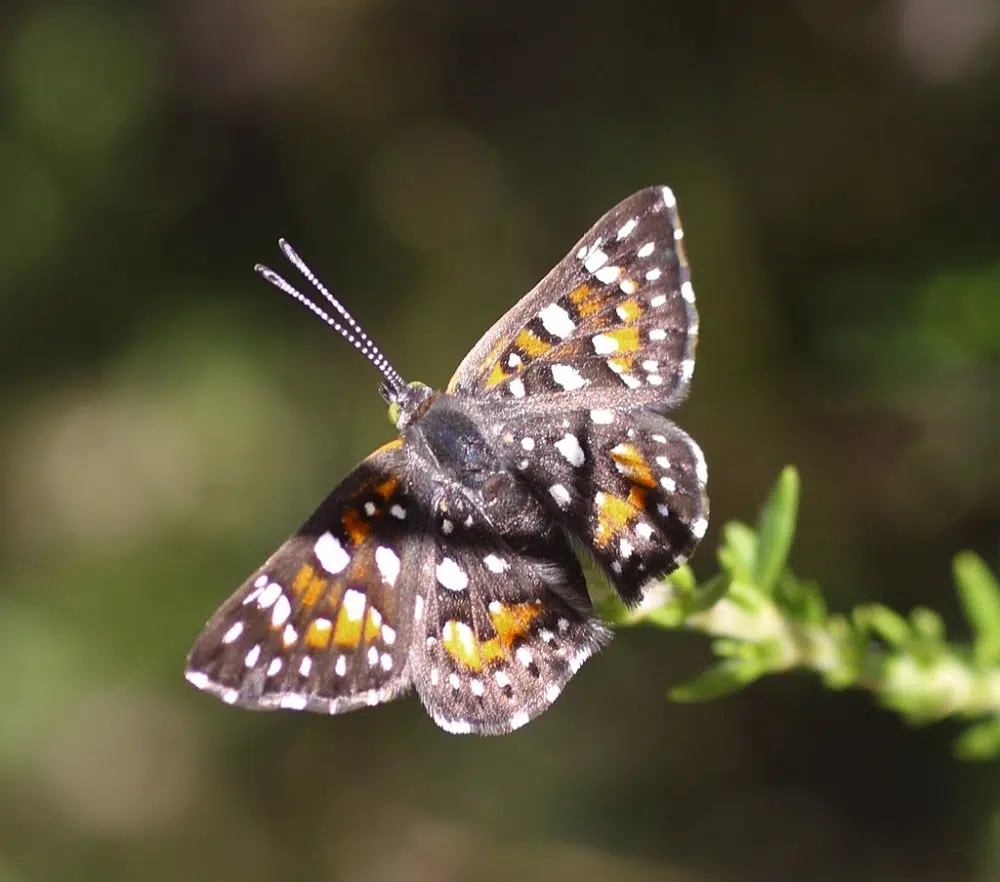
Behr’s Metalmark (Apodemia virgulti) is one of the most common species of butterflies that flies all year in South California.
Its presence is signaled South of Los Angeles and around San Diego down to Baja California.
The species has a preference for various species of buckwheat when it comes to hosting plants.
Behr’s Metalmark is some of the most common multicolored butterflies across eastern and coastal parts of California.
The species is active throughout the year in coastal San Diego.
Behr’s Metalmark butterflies have a gray to black coloring of the wings and black body color.
Orange to brown marks and black stripes are visible across its forewings and its hindwings.
This species also has white spots with black margins all across the wings. While not true eyespots, these white marks make the species stand out.
Dull ventral coloring is specific to Behr’s Metalmark. This species has mostly gray and orange ventral colors with large white spots that feature black borders.
29. Orange Sulphur
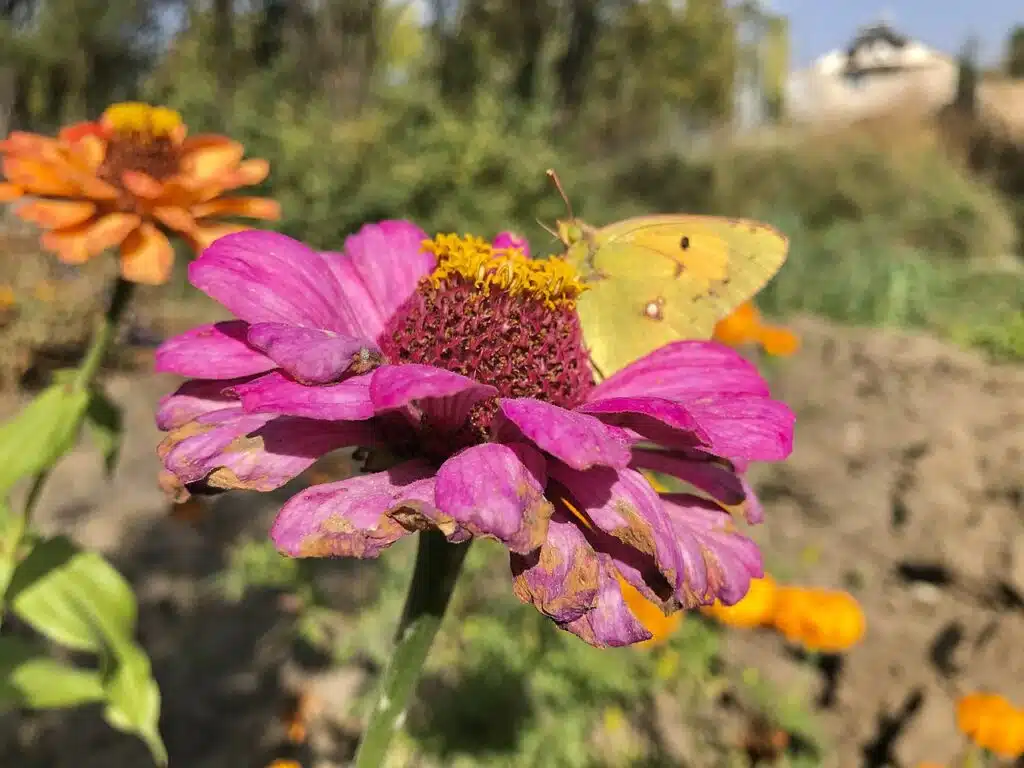
Orange Sulphur butterflies (Colias eurytheme) are some of the most common orange butterflies in California.
This species is known for its vivid dorsal and ventral coloring.
Orange is the main color of the dorsal wings. Dark brown patches across the margins of the wings are specific to both its forewings and its hindwings.
Its body is mostly black with black iridescence on the central forewings.
Orange Sulphurs can be both yellow and green ventrally.
This species has yellow ventral wings with just a few brown and white spots across the forewings.
A lime green morph on the ventral wings is also seen within this species.
Orange Sulphurs are some of the most damaging species in California despite their small size.
Caterpillars of the species tend to invade alfalfa crops. The damages they cause to these crops are considerable given these caterpillars are nocturnal.
Only feeding at night Orange Sulphur caterpillars also use pea family plants as hosts.